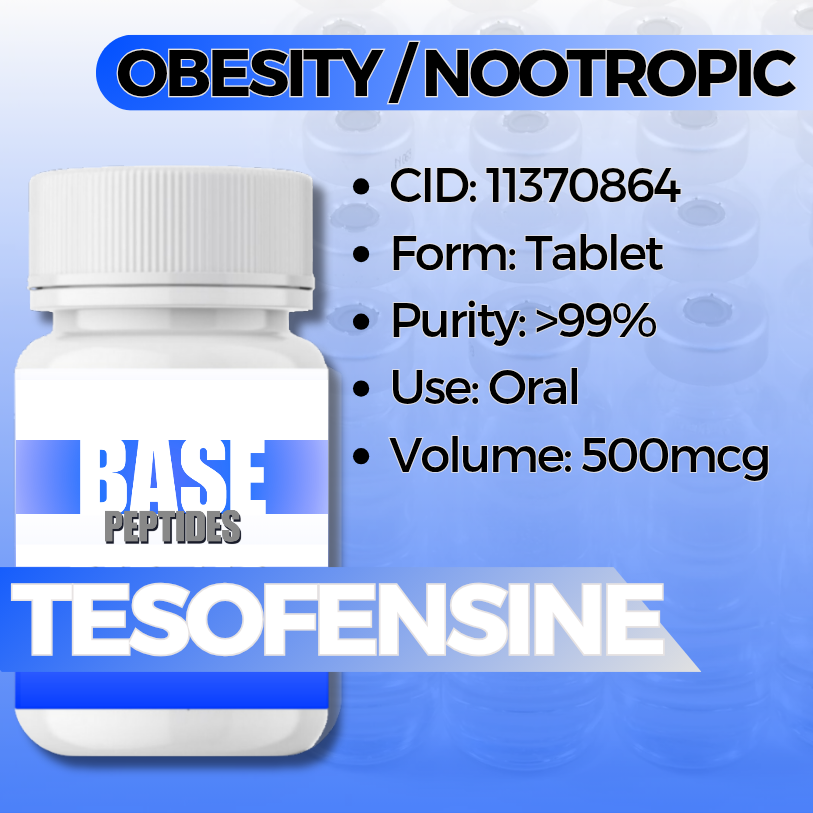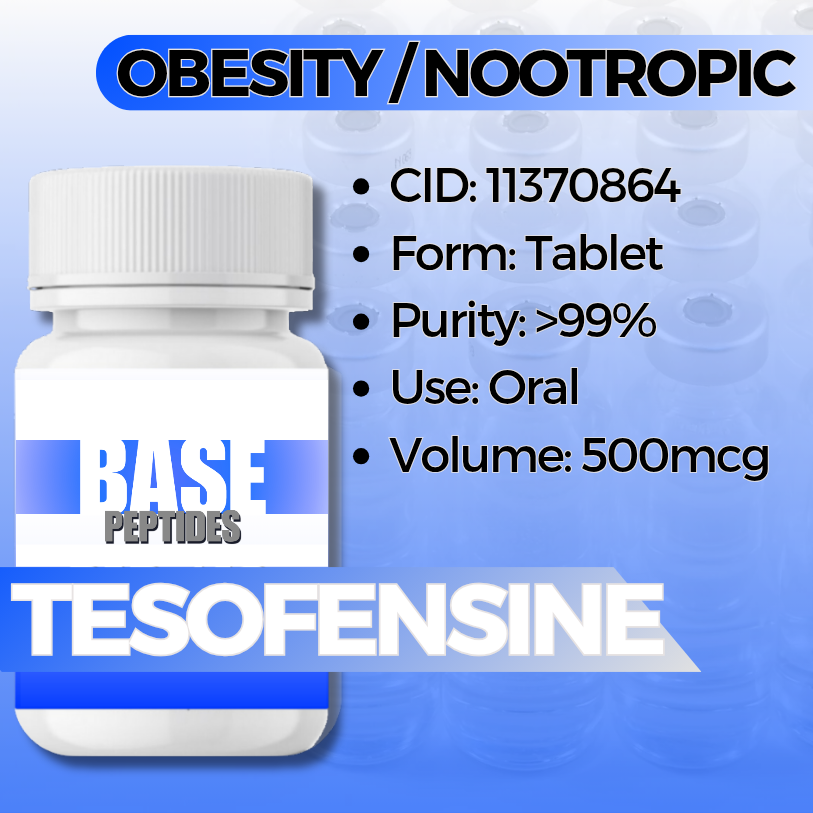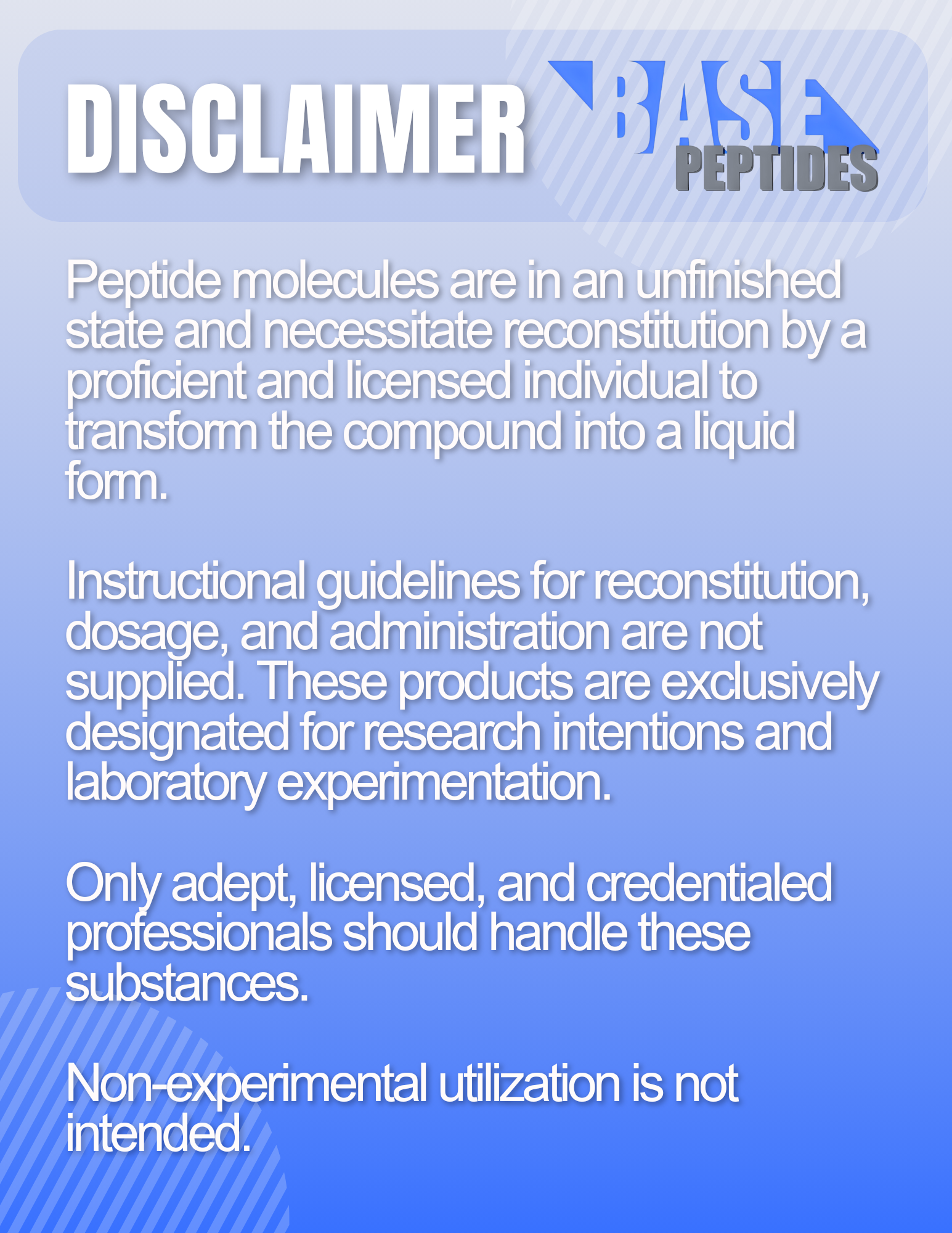Tesofensine
Tesofensine
Base Peptides are intended for licensed medical professionals and experienced researchers. Reconstitution required. Dosing and use instructions are not provided.
Couldn't load pickup availability
Tesofensine — Triple Monoamine Reuptake Inhibitor (Dopamine/Norepinephrine/Serotonin)
Tesofensine is a potent small-molecule inhibitor of the dopamine, norepinephrine and serotonin transporters (DAT, NET, SERT). Originally developed for neurological disorders, it demonstrated significant weight-loss and metabolic effects in obese human and animal studies. [oai_citation:0‡ScienceDirect](https://www.sciencedirect.com/topics/pharmacology-toxicology-and-pharmaceutical-science/tesofensine?utm_source=chatgpt.com)
- CAS No.: 195875-84-4 [oai_citation:1‡Wikipedia](https://en.wikipedia.org/wiki/Tesofensine?utm_source=chatgpt.com)
- PubChem CID: 11370864 [oai_citation:2‡Wikipedia](https://en.wikipedia.org/wiki/Tesofensine?utm_source=chatgpt.com)
- Mechanism class: Triple monoamine reuptake inhibitor (TMI) — DAT, NET, SERT [oai_citation:3‡PubMed](https://pubmed.ncbi.nlm.nih.gov/24239329/?utm_source=chatgpt.com)
- Approx half-life: ~220 hours (≈9 days) reported in humans; main metabolite ~374 hours. [oai_citation:4‡Wikipedia](https://en.wikipedia.org/wiki/Tesofensine?utm_source=chatgpt.com)
- By blocking the reuptake of dopamine, norepinephrine and serotonin, Tesofensine increases levels of these neurotransmitters in the brain. [oai_citation:5‡DrugBank](https://go.drugbank.com/drugs/DB06156?utm_source=chatgpt.com)
- This enhanced signaling affects appetite centres (especially in the hypothalamus), leading to reduced food intake (hypophagia) and increased satiety. [oai_citation:6‡PMC](https://pmc.ncbi.nlm.nih.gov/articles/PMC3055463/?utm_source=chatgpt.com)
- It also appears to modulate energy-expenditure pathways (via norepinephrine) and feeding-centres (via lateral hypothalamic GABAergic neuron suppression). [oai_citation:7‡PMC](https://pmc.ncbi.nlm.nih.gov/articles/PMC11042726/?utm_source=chatgpt.com)
- To study central appetite/hunger regulation mechanisms via monoaminergic pathways.
- To explore metabolic adaptation after weight loss and energy-balance regulation.
- As a comparative tool versus other appetite-suppression or weight-loss agents (e.g., GLP-1 agonists, stimulant analogues).
Key Study Themes — What’s Tested, What Changed, Why It Matters
Diet-Induced Obese Rats: Hypophagia & Weight Loss
- What was tested: Rats fed high-fat diet given Tesofensine (0.5-3.0 mg/kg, s.c. for 16 days) and food intake, weight change measured. [oai_citation:8‡PMC](https://pmc.ncbi.nlm.nih.gov/articles/PMC3055463/?utm_source=chatgpt.com)
- What changed: Marked decline in food intake (ED₅₀ ~1.3 mg/kg), significant weight loss vs vehicle. [oai_citation:9‡PMC](https://pmc.ncbi.nlm.nih.gov/articles/PMC3055463/?utm_source=chatgpt.com)
- Why it matters: Demonstrates mechanism of reduced intake + neural-circuit involvement in feeding. [oai_citation:10‡PMC](https://pmc.ncbi.nlm.nih.gov/articles/PMC3055463/?utm_source=chatgpt.com)
Human Obesity Trial (Phase II) – Body-Weight Loss
- What was tested: Obese participants given Tesofensine (0.25 mg, 0.5 mg or 1 mg daily) + diet/exercise for 6 months. [oai_citation:11‡Wikipedia](https://en.wikipedia.org/wiki/Tesofensine?utm_source=chatgpt.com)
- What changed: Average weight loss ~6.7 kg (0.25 mg), ~11.3 kg (0.5 mg), ~12.8 kg (1 mg) over 6 months; placebo ~2.2 kg. [oai_citation:12‡Wikipedia](https://en.wikipedia.org/wiki/Tesofensine?utm_source=chatgpt.com)
- Why it matters: Shows potent appetite/weight outcome compared to older agents—valuable translational data. [oai_citation:13‡4Ever Young Anti Aging Solutions](https://4everyoungantiaging.com/anti-aging-tips/tesofensine-explained-a-new-approach-to-weight-loss-and-metabolism/?utm_source=chatgpt.com)
Potential Research Applications
Appetite & Hunger Regulation
- Hypothalamic circuits, feeding behaviour, GABAergic inhibition in the lateral hypothalamus. [oai_citation:14‡PMC](https://pmc.ncbi.nlm.nih.gov/articles/PMC11042726/?utm_source=chatgpt.com)
Obesity / Metabolic Adaptation Models
- Energy-balance adaptation, post-weight-loss rebound, diet-resistance models. [oai_citation:15‡PMC](https://pmc.ncbi.nlm.nih.gov/articles/PMC11042726/?utm_source=chatgpt.com)
Monoaminergic Neuropharmacology
- DAT/NET/SERT occupancy studies; compare with stimulant / antidepressant models. [oai_citation:16‡PubMed](https://pubmed.ncbi.nlm.nih.gov/24239329/?utm_source=chatgpt.com)
Synergistic / Comparator Agents
GLP-1 Agonists
- Why compare/partner: Alternative central appetite/hormone signalling; useful to compare mode of action (monoamine vs gut-brain).
Peptides: MOTS-c, CJC-1295/Ipamorelin
- Why compare: While Tesofensine targets central monoamines and appetite, peptide blends target metabolic/mitochondrial or GH/IGF axes—combined designs may dissect multiple layers of weight/regulation biology.
Design Notes
- Include baseline hunger/appetite questionnaires, neurotransmitter marker panels (if possible), diet/exercise control arms.
- Track cardiovascular parameters closely—monoamine modulators often increase HR/BP. [oai_citation:17‡Wikipedia](https://en.wikipedia.org/wiki/Tesofensine?utm_source=chatgpt.com)
Known Concerns (Context)
- Cardiovascular effects:
- Stimulant-like risks:
- Regulatory status:
- Monoamine modulation confounds:
Specifications & Handling
- Form: Oral small-molecule compound (lot-coded) — confirm salt/chemical form.
- Purity: Research-grade specification (HPLC/MS, ≥98%).
- Storage: Manufacturer recommended; typically cool, dry conditions; protect from light/moisture.
- In use: Dose and vehicle must be clearly documented; in vivo rodent dosing vs human research differs—specify model and route.
Regulatory & Use Notice
Sold for laboratory research use only. Not for human consumption, medical, or veterinary use. No human-use instructions are provided. Buyer is responsible for safe handling, regulatory compliance, and observing local jurisdiction laws.
Tesofensine Research Compound | Monoamine Reuptake Inhibitor | Appetite Control & Weight-Loss Mechanism Studies






